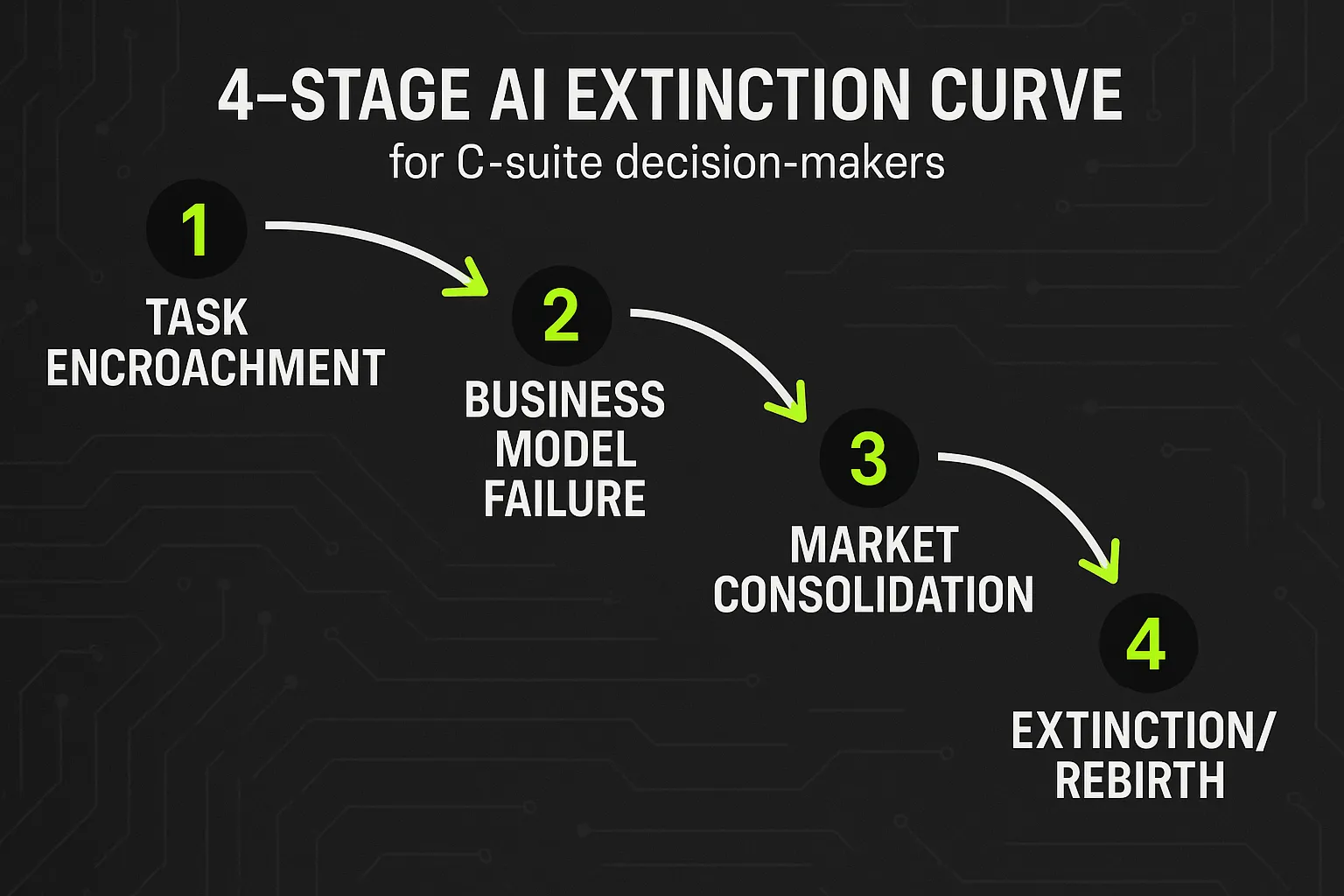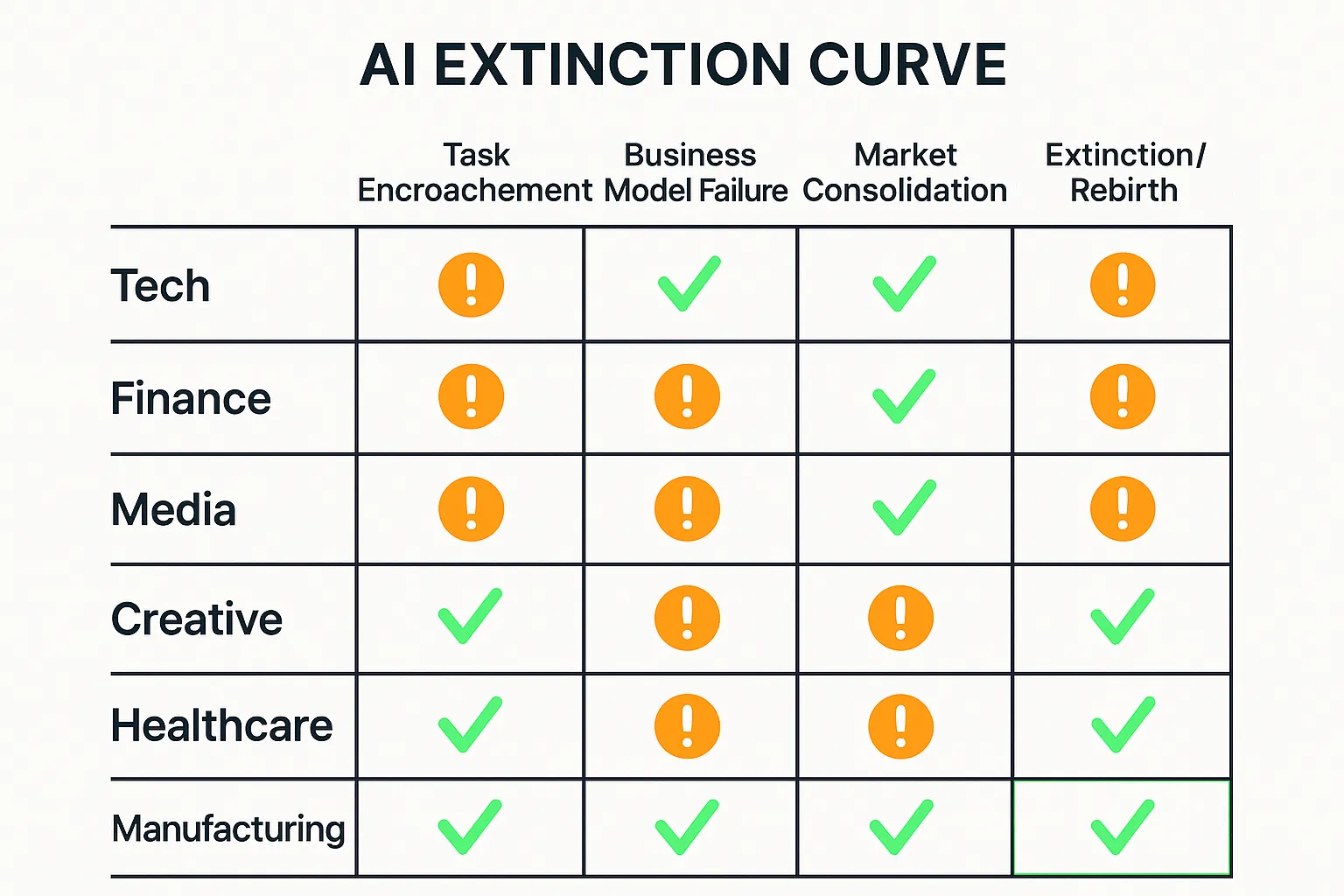The AI Extinction Curve: Is Your Industry Next?
AI Summary
The AI Extinction Curve outlines the urgent framework for business leaders to assess and navigate AI-driven disruption. This guide highlights the stages of market transformation and strategies to safeguard your industry position.
- Who:
Business leaders and decision makers facing AI disruption. - What:
A strategic framework to evaluate AI vulnerability and build resilience. - When:
Immediate and ongoing, as AI disruption accelerates rapidly. - Where:
Across industries globally, with specific risk benchmarks per sector. - Why:
To identify threats early and adopt actionable mitigation for survival and competitive advantage.
Every business leader today feels it. There's a persistent, low-grade anxiety about Artificial Intelligence. You read the reports from J.P. Morgan and Goldman Sachs, filled with macroeconomic predictions and cautious analysis. They talk about productivity gains and job market shifts in abstract terms. But their data, while authoritative, lacks a critical component. It fails to provide a clear, strategic framework for you to understand the immediate threat to your specific business.
This isn't just another technological cycle. This is an extinction event, and it's happening faster than any previous disruption. The old playbooks for tech adoption won't work. What you need isn't more data. You need a map.
This guide introduces the AI Extinction Curve. It is a practical framework designed for business leaders to move beyond the headlines, benchmark their industry's vulnerability, and identify the exact point where disruption becomes an existential threat. This is your map for navigating what's next.
The Extinction Curve Framework: A C-Suite Guide to AI Vulnerability
The AI Extinction Curve isn't a forecast. It's a diagnostic tool that plots the four stages of AI-driven market disruption. Understanding where your industry sits on this curve is the first step toward building a resilient business. Ignoring it means choosing to be a victim of the inevitable consolidation to come.

Here are the four stages:
Stage 1: Task Encroachment
This is the entry point of disruption. AI doesn’t take jobs; it starts by taking tasks. Research from ARXIV shows that 80% of the U.S. workforce will soon find AI impacting at least 10% of their daily tasks. This stage feels like a productivity boost. Your team uses AI to write emails, generate code snippets, or draft initial reports. The danger is deceptive because efficiency masks the underlying devaluation of the skills required to perform those tasks manually.
Stage 2: Business Model Failure
Task encroachment accelerates until AI reaches a "good enough" tipping point. AI-generated output, while not perfect, becomes viable for a significant portion of the market. This development crashes the marginal cost of production. Suddenly, the market is flooded with low-cost alternatives, whether it's graphic design, legal document review, or market analysis. Businesses built on the old cost structure can no longer compete. A survey by the Society of Authors found that 26% of illustrators are already losing work to AI. This is a clear signal of a market entering Stage 2.
Stage 3: Market Consolidation
As existing business models fail, the market consolidates. Companies that integrated AI into their core operations from the beginning now hold an insurmountable competitive advantage. They leverage automation to operate at a scale and price point that legacy businesses cannot match. Weaker players are acquired for their client lists or simply go out of business. This is where we see large-scale job displacement, such as the 77,999 tech jobs lost to AI adoption in the first half of 2025 alone.
Stage 4: Extinction and Rebirth
The old industry is effectively gone. The fundamental assumptions about how value is created have changed forever. However, this stage also brings rebirth. New industries and roles emerge from the ashes, built entirely on an AI-native foundation. The World Economic Forum projects AI will displace 92 million jobs by 2030 but also create 78 million new ones. The new jobs will require skills in strategy, system management, and creative oversight, not manual execution.
Industry-by-Industry Vulnerability Index
To make this framework actionable, we've mapped key industries against the Extinction Curve. This index is designed to give you a clear benchmark of your sector's current risk level. Use it to understand the speed and severity of the changes heading your way.

Analysis of Key Sectors:
- High Risk (Deep in Stage 2 / Entering Stage 3):
- Creative & Media: The "good enough" tipping point has been reached for stock imagery, basic copywriting, and voiceover work. The market is flooding with cheap alternatives, pushing business models centered on human creators to the brink. Surviving requires a pivot to high-level strategy and unique, inimitable quality.
- Customer Support: AI chatbots and automated response systems are now capable of handling the vast majority of Tier 1 inquiries, leading to the collapse of traditional call center models.
- Technology (Entry-Level): Roles in quality assurance testing, basic code generation, and IT support are experiencing severe task encroachment, leading to smaller team sizes and a higher bar for entry-level talent.
- Moderate Risk (Firmly in Stage 1):
- Finance & Law: AI is rapidly automating data analysis, compliance checks, and legal discovery. While human oversight is still critical, the sheer volume of work done by AI is changing team structures and skill requirements. Wall Street is projected to replace 200,000 roles with AI by 2030, a clear sign of a sector in transition.
- Consulting: Data gathering and initial analysis, once the bread and butter of junior consultants, are now automated. Value is shifting toward strategic interpretation and client relationship management.
- Lower Risk (Pre-Stage 1 / Early Stage 1):
- Skilled Trades & Healthcare: Industries requiring fine motor skills, physical dexterity, and direct human interaction currently have a strong defense against AI disruption. While AI assists in diagnostics and logistics, the core value delivery remains human-centric.
Deep Dive: The Anatomy of an AI Extinction Event (Case Studies)
Theory is useful, but seeing the mechanics of disruption in a real-world scenario makes the threat tangible. Let's dissect the extinction event currently underway in the content creation market.

This case study demonstrates how quickly a market can move from efficiency gains to total disruption. Companies that once paid for articles and blog posts are now questioning that spend. The only way to compete is to deliver value that AI cannot replicate. This requires a shift from simple content production to sophisticated, data-driven strategic content intelligence that directly impacts business goals.
The Path to Resilience: Mitigation Strategies & The AI Transformation Bridge
Your position on the Extinction Curve is not your destiny. It is a diagnosis. With a clear strategy, you can transform this existential threat into a competitive advantage. The goal is to build an AI-native business that operates with speed and intelligence, freeing your human team to focus on innovation and growth.
This requires moving beyond simple tool adoption. You need a structured approach to integrating automation into the core of your business.

Here is a five-step roadmap to resilience:
- Benchmark Your Vulnerability: Use the Index to identify your current position on the curve. Be ruthlessly honest about which of your company's tasks are most susceptible to automation.
- Identify High-Impact Automation Opportunities: Map your core business processes. Pinpoint the manual, repetitive tasks that create bottlenecks and increase costs. These are your prime targets for initial AI implementation.
- Implement Pilot Programs: Start small. Select one or two key processes and build a simple, automated system around them. The goal is a quick win that demonstrates ROI and builds momentum.
- Reskill Your Workforce: Your team's value shifts from execution to oversight. Train them to manage the new automated systems, interpret AI-driven insights, and focus their energy on high-level strategic activities.
- Reinvent Your Value Proposition: With AI handling the operational workload, you can deliver your product or service faster, cheaper, and with higher quality. This becomes your new competitive advantage.
Executing this strategy can feel overwhelming, but it doesn't have to be complex or expensive. A dedicated Transformation Strategist can help you design and implement these simple, automated systems in weeks, not years.
Frequently Asked Questions
Is this just another tech hype cycle like the dot-com bubble?
While there is significant hype, the underlying technology is different. Previous disruptions, like PCs and the internet, were tools that changed how humans worked. Generative AI is a tool that can perform the work itself. Academic analysis from institutions like Yale provides historical context, but it often misses the unprecedented velocity of this shift. The speed of adoption and improvement is what makes this a fundamentally different type of event.
Our business has unique needs. How can a standardized AI approach work for us?
It can't. A one-size-fits-all approach is doomed to fail. True AI transformation is not about buying off-the-shelf software. It is about designing custom workflows and simple automated systems that integrate with the tools you already use. The solution must be tailored to your specific business ecosystem to be effective.
We don't have a huge budget or a team of data scientists. Isn't AI implementation too expensive and complex for us?
This is a common misconception driven by large enterprise case studies. For small and medium-sized businesses, the focus should be on practical, cost-effective automation, not building complex proprietary models. The goal is to implement simple systems that deliver a clear and immediate return on investment, often within weeks, by eliminating manual processes and increasing operational efficiency.
Will AI completely replace my team?
For most businesses, the answer is no. It will, however, fundamentally change what your team does. As our research shows, the immediate impact is on tasks, not entire jobs. AI will automate the repetitive, low-value work. This elevates your human team, freeing them to focus on the things AI cannot do: building client relationships, innovating on strategy, and making complex executive decisions. It's about augmentation, not replacement.
Your Next Step: From Awareness to Action
Understanding the AI Extinction Curve gives you a powerful advantage. You can now see the path of disruption with clarity. The next move is yours. You can wait for the changes to hit you, or you can take control and begin building a more resilient, efficient, and intelligent business.
The choice is not whether to adopt AI, but when and how. Proactive adaptation is the only strategy for survival and growth.
If you are ready to move from awareness to action, schedule a complimentary AI strategy session. We will help you benchmark your business against the curve and map out the first steps on your path to resilience.


